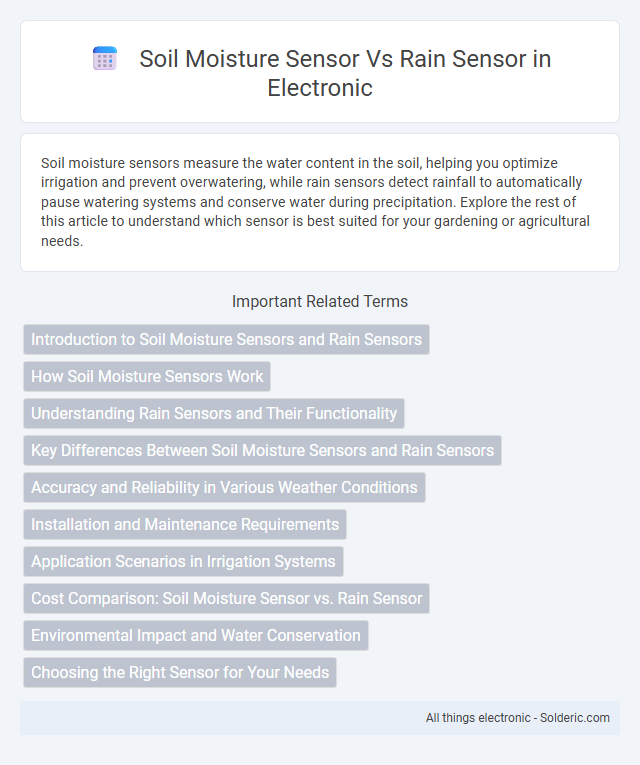Soil moisture sensors measure the water content in the soil, helping you optimize irrigation and prevent overwatering, while rain sensors detect rainfall to automatically pause watering systems and conserve water during precipitation. Explore the rest of this article to understand which sensor is best suited for your gardening or agricultural needs.
Comparison Table
| Feature | Soil Moisture Sensor | Rain Sensor |
|---|---|---|
| Purpose | Measures soil water content | Detects rainfall presence |
| Primary Use | Irrigation control based on soil moisture | Automatic rain detection for weather systems, irrigation control |
| Measurement Type | Volumetric water content in soil | Rain presence or intensity |
| Sensor Technology | Capacitive, resistive, or time-domain reflectometry | Optical, resistive, or capacitive |
| Installation Location | Inserted into soil root zone | Mounted externally exposed to sky |
| Data Output | Analog or digital moisture level | Binary rain detection or analog rain intensity |
| Application Examples | Agriculture, landscaping, smart irrigation | Weather stations, irrigation shutdown, smart home |
| Accuracy Focus | Soil water content accuracy | Rain detection sensitivity |
Introduction to Soil Moisture Sensors and Rain Sensors
Soil moisture sensors measure the volumetric water content in soil, providing precise data essential for efficient irrigation management in agriculture and landscaping. Rain sensors detect precipitation levels, automatically shutting off irrigation systems during rainfall to prevent water waste. Both sensors enhance water conservation by optimizing irrigation schedules based on environmental conditions.
How Soil Moisture Sensors Work
Soil moisture sensors measure the volumetric water content in soil by detecting changes in electrical resistance or dielectric permittivity, which vary with moisture levels. These sensors provide precise data on soil hydration, enabling targeted irrigation and improving water efficiency. Unlike rain sensors that detect precipitation to prevent irrigation during rainfall, soil moisture sensors offer real-time feedback on actual soil conditions for optimized watering.
Understanding Rain Sensors and Their Functionality
Rain sensors detect precipitation by measuring the amount of rainfall on a surface, triggering automated responses such as pausing irrigation systems to prevent water waste. Unlike soil moisture sensors, which monitor the water content within the soil to optimize irrigation scheduling, rain sensors focus solely on detecting environmental rainfall. Effective rain sensors use technologies like capacitive or optical sensing to ensure accurate and timely watering adjustments in smart irrigation systems.
Key Differences Between Soil Moisture Sensors and Rain Sensors
Soil moisture sensors measure the volumetric water content in soil to optimize irrigation schedules and prevent overwatering, while rain sensors detect rainfall to temporarily halt irrigation systems and avoid unnecessary watering. Soil moisture sensors provide real-time data on soil hydration levels, enabling precise water management tailored to crop or landscape needs. In contrast, rain sensors act as a simple on/off switch that interrupts irrigation during rainfall events without assessing soil conditions.
Accuracy and Reliability in Various Weather Conditions
Soil moisture sensors provide high accuracy by directly measuring volumetric water content in soil, offering reliable data essential for optimized irrigation management across diverse weather conditions. Rain sensors detect precipitation but can be less precise in determining soil hydration levels, potentially leading to over- or under-watering in varying climates. The reliability of soil moisture sensors remains consistent during dry spells or after rainfall events, whereas rain sensors may fail to account for soil absorption rates and evaporation, affecting overall irrigation efficiency.
Installation and Maintenance Requirements
Soil moisture sensors require burial at root depth for accurate readings and periodic calibration to avoid sensor drift, while rain sensors are typically installed on rooftops or exposed surfaces and need regular cleaning to prevent debris buildup. Both sensors demand minimal wiring for power and signal transmission, but soil moisture sensors may require occasional repositioning due to soil disturbances. Maintenance routines for rain sensors mainly focus on sensor lens cleaning and checking for mechanical obstructions that can affect precipitation detection.
Application Scenarios in Irrigation Systems
Soil moisture sensors monitor the water content in the soil, making them ideal for precise irrigation scheduling by ensuring plants receive optimal hydration without overwatering. Rain sensors detect precipitation to prevent irrigation systems from running during or after rainfall, conserving water and protecting against soil erosion. Your irrigation system benefits from integrating both sensors, enabling efficient water use tailored to real-time environmental conditions.
Cost Comparison: Soil Moisture Sensor vs. Rain Sensor
Soil moisture sensors generally incur higher initial costs compared to rain sensors due to their advanced technology that measures moisture levels directly in the soil. Rain sensors tend to be more affordable, as they simply detect rainfall presence without quantifying soil conditions. Long-term maintenance expenses for soil moisture sensors may also exceed those of rain sensors, reflecting their complex calibration and sensitivity requirements.
Environmental Impact and Water Conservation
Soil moisture sensors optimize irrigation by detecting precise soil hydration levels, reducing water waste and minimizing runoff that can lead to environmental degradation. Rain sensors prevent irrigation during rainfall, conserving water and lowering the energy needed for pumping, thereby reducing carbon emissions. Both technologies play crucial roles in sustainable water management by enhancing resource efficiency and protecting ecosystems.
Choosing the Right Sensor for Your Needs
Soil moisture sensors measure the volumetric water content within the soil, providing precise data for irrigation management, while rain sensors detect precipitation to prevent irrigation systems from running during rainfall. Selecting the right sensor depends on whether your priority is real-time soil hydration data or weather-triggered irrigation control. For efficient water use, soil moisture sensors offer targeted irrigation adjustments, whereas rain sensors help avoid unnecessary watering during wet conditions.
Soil moisture sensor vs rain sensor Infographic

 solderic.com
solderic.com